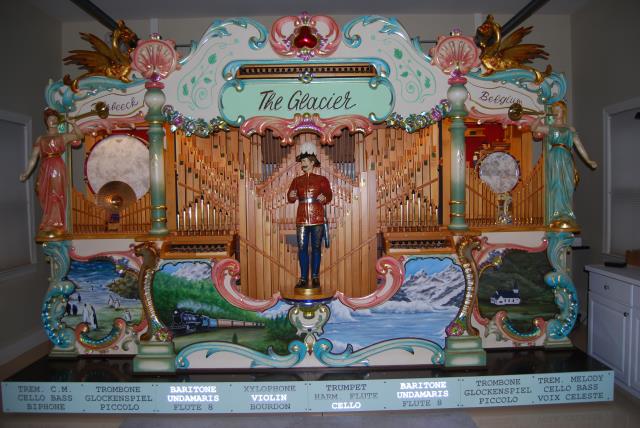Verbeeck 112 Key Concert Organ

VERBEECK 112 KEY FAIRGROUND / CONCERT ORGAN “The Glacier”
In the tradition of the great Carl Frei, pioneer Dutch designer and builder of the famous Dutch street organs, this new organ is a larger example of those famous organs that have plied the streets of the Netherlands for years. The added registers and pipes allow the organ to do additional duty as a European fairground and concert in the style of great builders Gavioli and Marenghi.
Musically, the organ is able to duplicate the sweet, melodious sounds of the cart – driven and hand cranked organs that have and continue to be seen on the streets of Amsterdam and surrounding communities. Yet, the organ has added registers in the melody, counter – melody, and bass that add greater depth and volume that were common in fixed entertainment venues in Europe.
The sounds of these types of European organs are quite different than the loud, brassier sounds of American band organs, such as Wurlitzer, Artizan, and North Tonawanda. Those organs were more oriented toward emulating the sounds and spirit of large marching bands, and usually had multiple trumpet registers and other dominant sounds. These organs made little use of solo registers, instead favoring a “forte” or loud “all-on” sound for maximum effect.
The European organ sound favored sweeter, more harmonious voicing, lots of different registers not seen in American organs, and often played solo, paired or tripled, for a more orchestral sound. The music was more oriented toward a fairground or concert venue, hence the name.
In designing this organ, 4th generation organ builder Johnny Verbeeck sought to achieve a unique sound. This is one of the largest new organs built for decades either in the states or in Europe. Its 112 keys, 17 automatic registers, 557 pipes, and five separate chromatic scales in melody, counter melody, 3rd melody, accompaniment, and bass also represent one of the larger scales for any European organ, old or new playing today.
The organ is powered by a very large electrical motor which drives a large flat-belt driven huge wheel that drives a huge pressure bellows capable of supplying enough wind for the organ’s extensive valve chest, 557 pipes and percussion.
The façade, including the leafing and finishing, is a Verbeeck design inspired by composites of various vintage Gavioli and Marenghi organs selected by Glenn Thomas. The four illustrations represent “Glacier” themes from trip photographs taken by Glenn Thomas and Kim Kleasen to Montana Glacier National Park, Alaska Denali National Park, and the Antarctica..
The organ has 112 playing “keys” which include notes, registers, and percussion. The full 112 keys operate on a non-invasive midi system which was added to greatly increase the diversity and variety of music. This system allows computer digitally arranged files to be played bypassing the punched cardboard music system.
The organ also has a traditional “key frame” which has 92 keys. The key frame omits the 3rd melody 18 notes and two registers (bells and piccolos) in the interest of space.
The key frame system is traditional on European organs and plays the organ using heavy, wide folding cardboard “books.” Originally, arrangers hand punched these books from penciled markings directly on the cardboard. Now, higher speed computer driven punching machines are used.
The large musical library of cardboard books and midi files is a mix of traditional popular and classical music from many of Europe’s best arrangers. The music library continues to expand.
Musical Composition: 557 pipes in 17 automatic registers plus percussion.
* = Automatic Registers.
See below the table for explanation of some of the more unusual pipe registers.
Melody
Counter Melody
3rd Melody (midi only)
Accompaniment
Bass
Percussion
Undamaris - Two ranks of celeste-tuned string pipes, tuned an octave below the violins, producing an undulating “waves of the seas” sound.
Bourdon - Two ranks of loudly voiced melody flutes tuned to a strong celeste with a distinct sound.
Flute Harmonique – An open flute with a small hole, causing a sound an octave higher than normal, and with greater tonal stability. Not quite as loud as a piccolo.
Voix Cellest – Two ranks of violin pipes tuned in celeste, an octave above other counter melody ranks, often producing long, sustained chords, serving the musical function of backup singers.
Cello – String pipe constructed like a violin, but with a lower pitch.
Baritone – Two ranks of simultaneous sounding pipes: saxophone and open flutes.
Cello Grave – Large 16” string pipe, used for very low sounds like that of a baritone saxophone.
Flute 8 – A wide-scaled flute producing a soft, but penetrating sound; occurring at 8′ pitch.
Biphone – Two ranks of stopped flutes playing at 16’ and 8’ pitch.
Tremulant – Interrupted wind supply to produce rapidly repeating notes for a unique effect.
Stopped Octave – A 4’ rank of flutes.
Sonata in C by Mozart
Arr: Tom Meijer
Push Through Rag
Transcription by Tom Meijer.
Angels (Robbie Williams)
Arr: Sjoerd Caspers
Wil Met Je Lachen. Beautiful Dutch Ballad.
Arr: Sjoerd Caspers
Al Jolson Medley
